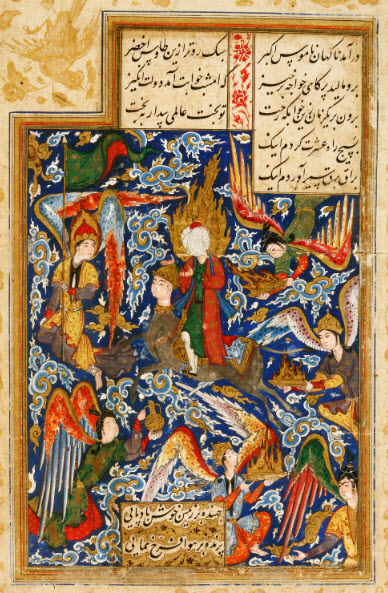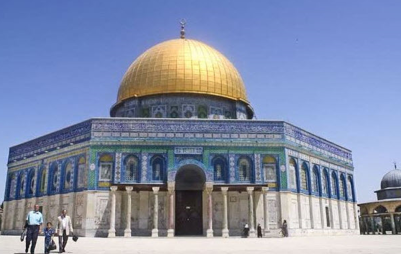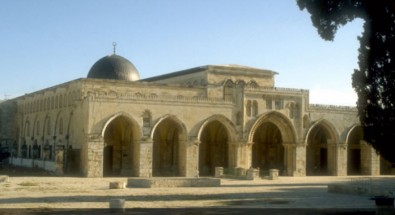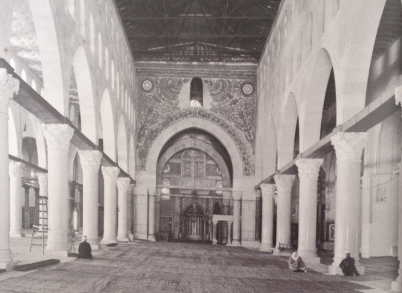http://www.ismaili.net/Source/0583.html[b]Mi’raj – A soul’s journey towards spiritual knowledge[/b]
Posted by Nimira Dewji
Exalted is He who took His Servant by night from al-Masjid al-Haram to al-Masjid al-Aqsa, whose surroundings We have blessed, to show him of Our signs. Indeed, He is the Hearing, the Seeing.
Surat al-Isra, Qur’an 17:1
The ascension of Prophet Muhammad into heaven, mi’raj, is generally celebrated on the 27th day of Rajab. In this legend, the Prophet was prepared for his meeting with God by the archangel Jibril (Gabriel) one evening while he was asleep. The Prophet’s heart was purified by removing all traces of error and doubt, and was filled with wisdom and belief.
The Prophet then made his night journey (isra) from the sacred place of worship (masjid al-haram) to the further place of worship (masjid al-aqsa) on the winged mythical creature Buraq, and from there he ascended to heaven, by ladder (miʿraj), accompanied by Jibril. The Prophet was greeted by, and in effect validated by the previous Prophets (Adam, Joseph, Aaron, Moses, Abraham, and Jesus) and then saw the Divine Throne.
Amongst the esoteric traditions of Muslims, the legend of mi‘raj is symbolic of the spiritual search, describing the soul’s leap into mystic knowledge, and eventually to the state of spiritual union with the Divine.
The tenth century Ismaili Da‘i, Abu Hatim al-Razi, in his interpretation of the Prophet’s mi’raj, “noted that Buraq is derived from the Arabic verb baraqa (“to shine”), suggesting the horse symbolizes an illuminating experience or illuminating knowledge granted by a spiritual rank (hadd) of the higher world known as Khayal (Imagination). This light, which emanates from the Universal Soul, “shone” (baraqa) upon the Prophet and elevated him to the higher spiritual rank of Jadd (Good Fortunate), and finally to the Universal Soul and Universal Intellect” (Khayal ‘Aly, Ismaili Gnosis).
“The connection of the mi’raj with daily prayer – which was experienced by Muhammad…[made the ascension] into the divine presence possible for every sincere Muslim” (Mystical Dimensions of Islam p 218-219). Mi’raj is the the mystical Path, the journey of the soul from God and back to God; only such a journey can bring a human to perfection (Mystical Dimensions of Islam p 222).
The story of the soul’s journey towards true knowledge has constituted a popular theme in Islamic art and poetry.
More on Mi’raj at Ismaili Gnosis.
miraj Prophet Muhammad
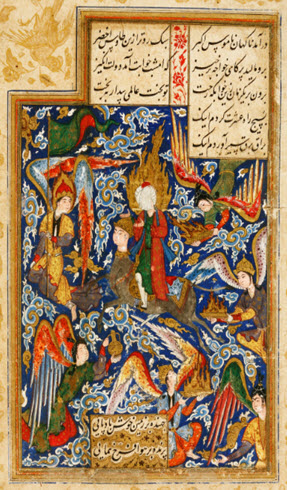
Painting of Prophet Muhammad’s Mystical Ascension to Heaven, dated Iran; c. 1580. The David Collection
According to Islamic tradition, the al-masjid al-haram is the area that surrounds the Ka’baa and although the Qur’an does not say where al-masjid al-aqsa is, scholars believed it to be located in modern-day al-Haram al-Sharif (‘The Noble Sanctuary’) in Jerusalem. The term masjid means simply ‘place of prostration’ and does not imply a specific structure where the Prophet prostrated to God before his ascent. The term masjid al-aqsa was applied to the area as a whole and also to the mosque which was built there subsequently, in the seventh century, close to the Dome of the Rock, also built in the seventh century.
The Noble Sanctuary, an open-air platform built during the first century BCE to house Jewish temples, is sacred to the Abrahamic traditions: it was where the First and Second Temples of Jerusalem stood, as well as the Temple of Solomon that was destroyed by the Romans in 70 CE; the site where Prophet Ibrahim prepared to sacrifice his son; the location where Hazrat Isa spent a few days sitting among learned men and teaching others; and is linked to the Prophet’s isra and mi’raj.
When the Umayyads conquered Jerusalem, the Caliph Abd al-Malik commissioned the construction of the Dome of the Rock (Qubbat al-Sakhra), enshrining the rock believed to be the site from where Prophet Muhammad ascended to heaven. Completed in 691, it is the earliest Islamic monument that has survived and one of the most admired ones, although the original purpose for its creation continues to be debated to the present day. Since its construction the Dome of the Rock has undergone several modifications and restorations due to frequent earthquakes.

Dome of the Rock
Dome of the Rock. Source: Archnet
The earthquake of 1016 caused extensive damage to the Dome of the Rock during the reign of the Fatimid Caliph Imam al-Zahir (r.1021-1036), who commissioned its restoration in 1022-3, “according to three inscriptions carved on wooden beams….at the base of the dome.” (Bloom, Arts of the City Victorious, p. 81). Oleg Grabar deems the original mosaics to be Umayyad in origin “with restorations of high technical quality… accomplished in Fatimid time.” (Ibid, p 82). Although the mosaics have undergone frequent repairs over the centuries masking the identities of the original artisans, Bloom notes “one can say with certainty that significant work was done and that during al-Zahir’s reign there was a corps of craftsmen in Jerusalem able to restore damaged mosaics not only at the Dome of the Rock but also at the Aqsa Mosque” (Ibid).
The al-Aqsa Mosque, located close to the Dome of the Rock and which was built on the orders of Abd al-Malik in the late seventh century and completed by his successors around 715, also suffered extensive damage from the earthquake of 1016 and was re-built by the Fatimid Caliph Imam al-Zahir between 1034 and 1036.
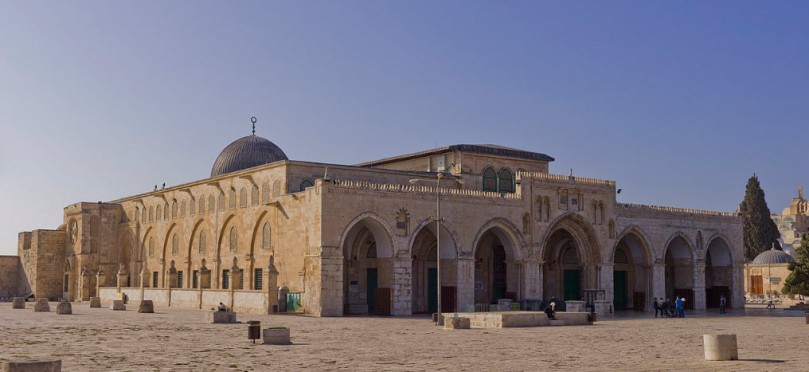
al-Aqsa Mosque
Northeast view of al-Aqsa Mosque. Source: Wikipedia
Reduced to seven aisles from the original sixteen, most of the central part of the present-day structure of the mosque dates from that time. Imam al-Zahir installed an Arabic inscription in Kufic script at the top of the central arch of the mosque, barely visible today, which includes the first verse of Surat al-Isra as well as the following:
“Has renovated its construction, our lord Ali Abu al-Hasan, the imam al-Zahir li-I’zaz Din Allah, Commander of the Faithful, son of al-Hakim bi-Amr Allah, Commander of the Faithful, may the blessing of God be on him, on his pure ancestors and on his noble descendants. By the hand of Ali ibn Abd al-Rahman, may God reward him. Supervised by Abu’l Qasim al-Sharif al-Hasan al-Husayni…may God help him.” (Bloom, Arts of the City Victorious, p 83).
al-aqsa mosque Fatimid al-zahir
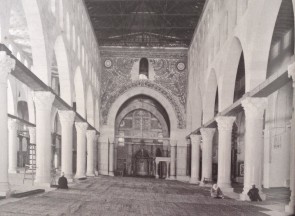
The main aisle of the Aqsa Mosque as it was in the 1940s, showing the mosaic inscription above the arch installed by the Fatimid Ismaili Imam al-Zahir. Source: The Ismailis An Illustrated History
al-aqsa Fatimid al-Zahir miraj meraj

Al-Aqsa Mosque arch as restored under Fatimid Caliph-Imam al-Zahir. Source: Arts of the City Victorious
Al-Aqsa miraj meraj
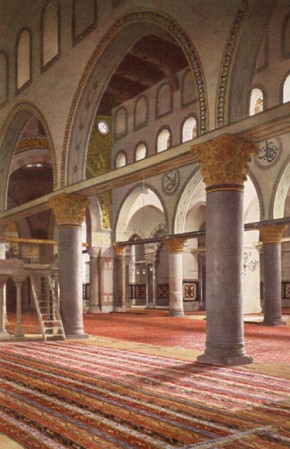
Jami Al-Aqsa, interior view from side aisle. Source: Archnet
The area of the mosque has had several restorations over the centuries, receiving the Aga Khan Award for Architecture in 1986 for its contemporary restoration.
Sources:
James W. Morris, The Mi’raj and Ibn ‘Arabi’s Own Spiritual Ascension
Jonathan Bloom, Arts of the City Victorious, Yale University Press, in association with The Institute of Ismaili Studies, 2007
Jami’ al-Aqsa, Archnet
Share this:
nimirasblog.wordpress.com/2020/03/20/miraj-a-souls-journey-towards-spiritual-knowledge/






